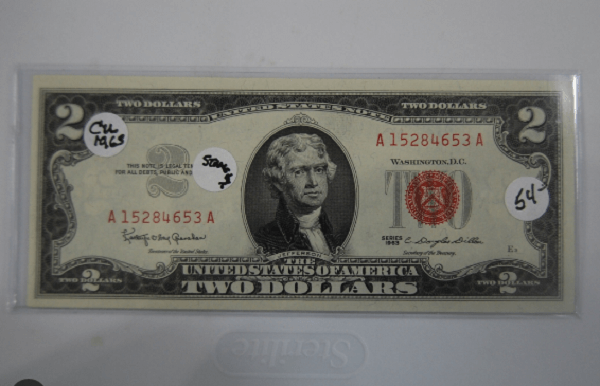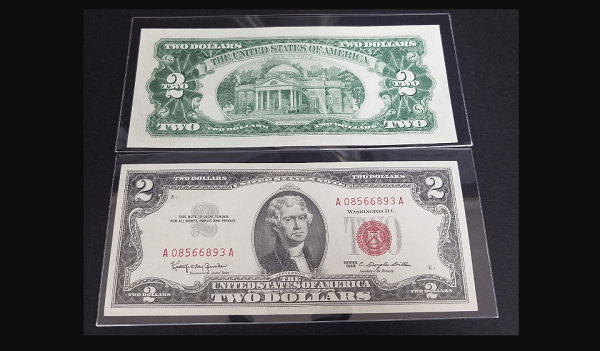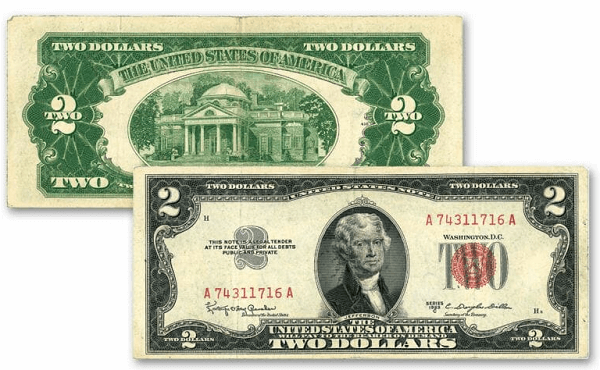1963 2 Dollar Bill Value – Did you know that the 1963 2 dollar bill is one of the rarest and most sought-after currency notes in the United States? This small piece of paper may not seem like much, but its value is far greater than its face value.
In fact, depending on its condition and specific features, a 1963 2 dollar bill can be worth anywhere from a few dollars to thousands of dollars.
In this blog post, we will delve into the fascinating history and rarity of the 1963 2 dollar bill and uncover its true value.
The 1963 2 dollar bill stands out with its red seal, distinguishing it from the standard green seal federal reserve notes and blue seal silver certificates. However, this isn’t the first red seal two dollar note in circulation.

The 1928 and 1953 two dollar notes also feature a red seal.
1963 marked the last year that the red seal was used on a two dollar bill, and it also marked the end of Jefferson’s Monticello residence being featured on US paper currency.
There were two series issued for this note, the 1963 and 1963A, both of which are common.
1963 $2 Bill History
Did you know that the first ever US $2 bills were issued in 1862? These bills were a type of note called Legal Tender Notes and featured the image of Alexander Hamilton.
Over the years, different types of $2 bills with various designs were produced.
The portrait of Thomas Jefferson, which we are familiar with on modern notes, also appeared in the 1963 versions.

However, $2 bills have never really caught on for everyday use, and their production was even discontinued in 1966.
Despite this, some special interest groups, like fans of Clemson University’s athletics teams, still use them for certain purposes.
1963 $2 Bill Value
If you have a 1963 $2 bill, it’s important to understand its value. There are several factors that determine the worth of these bills.
Check if your bill has a star alongside its serial number. Star bills are rarer and therefore more valuable to collectors. The condition of the bill is also important, with crisp, uncreased bills being worth more than those with tears or creases.

Grading agencies assign a grade from 1 to 70, with higher grades indicating better condition and higher value.
The serial number can also impact the value, with interesting numbers or patterns commanding higher prices.
Any notes with Treasury errors can be worth more. For the 1963A series, values are similar to the 1963 series.
Uncirculated bills, especially star notes, tend to have higher value. It’s worth noting that a 1963A $2 non-star bill with a perfect grade of 70PPQ sold for over $3,400.
1963 $2 Bill Errors
Errors can actually increase its value and make it even more collectible. One common error is an ink smear, which occurs during the printing process. The more dramatic the smear, the more valuable the note becomes.
However, it’s important to be cautious as these errors can also be easily faked. Always ensure that any note you’re considering buying has been independently authenticated before making a purchase.
Another type of ink error is known as an ink bleed. This happens when too much ink is applied to the note, causing it to bleed through to the other side.
For example, a 1963 $2 bill with an ink bleed on the Treasury seal was sold at auction in 2021 for $265.
This note was in better condition and graded 63 by the PMG.
1963 2 Dollar Bill Star Note
Did you know that there are special star notes for the 1963 2 dollar bill? These star notes are more valuable, especially when they are in uncirculated condition.
So, what exactly are star notes? They are replacement notes that have a star at the beginning of the serial number, making them more rare than standard notes.
The 1963A $2 star notes have similar values, with very fine notes worth around $12 and uncirculated notes with an MS 63 grade priced at around $90.
1963 2 Dollar Bill Grading System
To grade a 1963 2 dollar bill, there are two main categories to consider: very fine and MS 63 choice uncirculated. A very fine note has been in circulation but not for a long time, so it still maintains its crispness.
However, there may be some creases, folds, or light smudges present. On the other hand, an MS 63 choice uncirculated note shows no signs of ever being in circulation.
It retains its original crispness and is well-centered. Both of these grades can affect the value of a 1963 $2 bill, especially if it has a red seal.
How to Properly Maintain Your 1963 2 Dollar Bill
If you are lucky enough to have a 1963 2 dollar bill, you’ll want to make sure it stays in good condition to preserve its value.
Here are a few tips on how to properly maintain your 1963 2 dollar bill:
Handle it with clean hands, avoid folding or creasing it, store it in a protective sleeve or holder, and keep it away from direct sunlight or excessive humidity.
By taking these simple steps, you can ensure that your 1963 2 dollar bill retains its value for years to come.
How to Sell and Where to Trade Your 1963 2 Dollar Bill
If you’re considering selling or trading your 1963 2 dollar bill, there are a few options available to you.
- One option is to sell it through an online auction or marketplace dedicated to currency collectors. This can give you access to a wide audience of potential buyers and allow you to set your own price.
- Another option is to reach out to local coin and currency dealers or pawn shops to see if they’re interested in purchasing your bill. They may offer you a price based on its condition and rarity.
- You can explore attending currency shows or conventions where collectors and dealers gather to buy and sell currency. These events can provide a great opportunity to connect with buyers who are specifically interested in 1963 $2 bills.
The value of your 1963 $2 bill will depend on factors such as its condition, any unique features or errors, and the demand from collectors.
Conclusion
Well, the value of a 1963 two dollar bill can vary depending on factors like its condition and specific features. To determine its true worth, it’s best to consult with a currency expert or collector.
They can evaluate your 1963 $2 bill and provide an accurate estimate of its value.
Remember to carefully examine any ink smears or bleeds, as these errors can actually make the bill more collectible.
The value of your 1963 $2 bill can vary greatly depending on its unique characteristics, so it’s always a good idea to do some research and consult experts to determine its true worth.